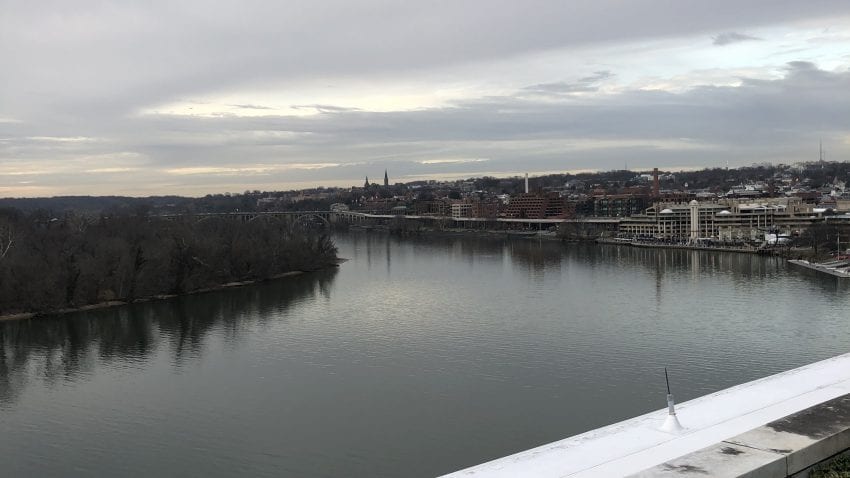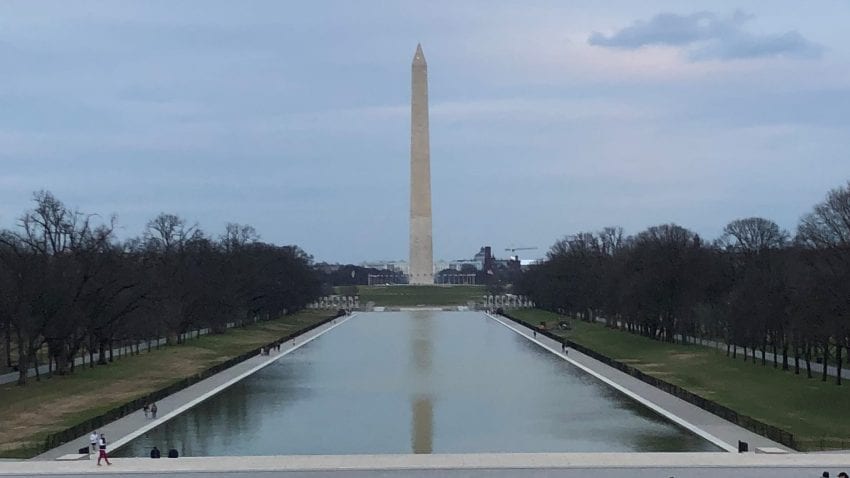After these 23 days in D.C. that went so fast yet lasted a lifetime, I have come to realize how entangled the government is in the arts and just how important it is to engage in art scenes. I experienced first hand the ways arts can engage in and detract from communities they are sourced from. Dance Place, the National Endowment for the Arts, and the Washington National Opera are just a few places we went that all represented different parts of the intersectionality of art and democracy.

View from the top of the Kennedy Center
The first time I understood D.C. separate from federal Washington was on the Attucks Adams Walking Tour. On that tour, we walked through the history of Black Broadway and U Street. The picture painted there was bleak. What was once a thriving center of African American music and art had changed rapidly after the uprisings of 1968 and the building of the metro. The metro tore out the pavement and customers of U Street, leaving just three black-owned businesses today. The murals the city commissioned for the neighborhood celebrate and immortalized black D.C. culture and musicians past and present, but what do they do for the neighborhood? They provide education and inspiration for everyone, even developers. The more the D.C. mural project goes on, the more developers are attracted to the neighborhood to buy real estate and push people out. This was the first time I realized the vast impact of art that can lurk under the surface of a seemingly harmless project.

The Washington Monument
The Smithsonians we visited were a good example of the more federal side of arts engagement. As federal museums, the Smithsonians are aware that their audience is the entire nation and often times even international. Yet, they also know the community they identify with, in and out of D.C. The National Museum of the American Indian provided a perfect example of arts activism and engagement even with the restrictions that accompany federal funding. Every institution we visited that had federal funding and affiliations had the same considerations for government involvement. At the NMAI, any controversy the public finds can cut their budget, yet their vision statement is “Equity and social justice for the Native peoples of the Western Hemisphere through education, inspiration, and empowerment.” To advance this vision the NMAI does take political stances. They are openly against the name of the Washington football team, though that position could potentially anger some people, advocating for social justice takes precedence. The NMAI’s mission statement is to work “In partnership with Native peoples and their allies, the National Museum of the American Indian fosters a richer shared human experience through a more informed understanding of Native peoples.” The museum makes good on their promise to work with Native peoples from the landscaping to the archives. The architecture and landscape elements at the museum were commissioned from native artists. The museum also cooperates with indigenous communities under their repatriation process and in order to fully understand objects in their collection. The NMAI does not let their federal label define who they are and what they want to achieve, which inspired me.
Entering into this course, I knew I wanted to work in museums and that maybe I wanted to be a curator. Now after seeing the inspiring work at the NMAI and the Smithsonian American Art Museum, who work to display a more comprehensive picture of America, and after speaking with curators at Folkways Recording Label and the National Museum of African History and Culture I am even more sure that is what I want to do. Seeing the incredible work of inclusivity and action at every organization I know where I can fit in civic engagement through a museum setting. Curation can be the first step towards accessibility in museums, I know I want to participate in the goal of making sure that every visitor sees themselves reflected in the collection and to make create stories of people and history. Making sure that the underrepresented have a voice and that the community the space exists in are attainable goals I will remember forever in my future journey.
Careers aside, because no one truly knows where they will end up while they are in college, I have seen many examples of community engagement anyone can do in D.C. A stand-out example was District Community Playback theatre. Half of the theatre was filled with D.C. residents of many years, there probably would have been more if our big group of Minnesotans had not been taking up the seats. There I felt out of place because the topic was stories of our experiences in D.C. Though our class was encouraged to participate, I felt that I had no stories that could compare to those that belonged in the community. The stories the community members shared were moving, they created a shared emotional response of inspiration through the crowd. In my short time in D.C., I did not feel I had earned the right to participate there. But, I do belong in a community somewhere and it made me wonder what opportunities for arts engagement exist right under my nose in my own communities. After spending this month engaged in the D.C. arts scene I know that I need to be more involved in the arts where I can.
What I ultimately want from the government in regards to the arts is more local engagement. If there is anything I have learned in this course it is that arts and democracy are imperfect practices. There is a diversity of opinions in our democracy especially when it comes to what to do with the arts. Should we increase support for the arts? Should artists be allowed to say and do whatever they want in the name of art? What even is art? Everyone has different answers to these questions and that is the beauty of art and democracy. I believe based on my experiences in D.C. that local government involvement in the arts has the highest potential for success in making changes. The local government can make a better judgement of what their community needs and implement those changes to include their communities. Going forward I will be more aware of my role as a participant in the civic and art worlds will engage where I can.
